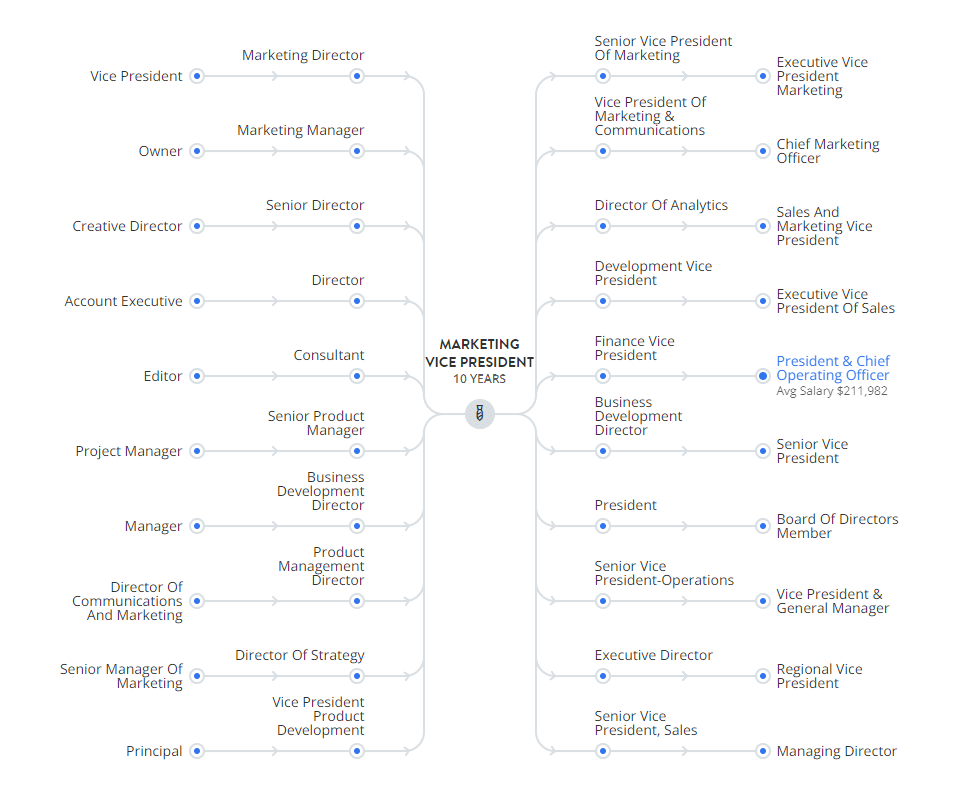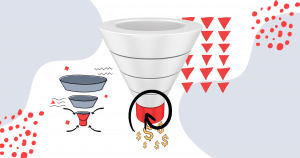A VP of marketing oversees an organization’s marketing efforts as they progress from strategy to execution. This executive plays a huge role in achieving a company’s revenue goal.
“I just got a job as the VP of marketing” is a line that almost every new marketer would like to say at some point in their career.
Having the final say on every marketing decision in an organization makes the position even more tempting.
Because the results, at the end of the day, represent your ability, and owning your results is a big deal in our world.
However, only a few marketers get to check off “becoming a VP of marketing” on their career bucket lists. There are several reasons why:
- Job applicants face a lot of competition.
- The opportunities are few and far between.
- Qualifications may not match the job description.
- Applicants don’t know the role of a marketing VP.
While some of the reasons stated above are beyond your control, you can increase the chance of landing your dream VP of marketing role when you understand the responsibilities tied to the job and have matching qualifications—two factors that you can control.
That’s where this article comes in. It will help you understand the job description of a marketing VP, the position’s requirements, and how to become this type of executive.
- What Does the Role of VP of Marketing Entail?
- What Are the Responsibilities of a VP of Marketing?
- What Skills Do You Need To Become a VP of Marketing?
- How To Become a VP of Marketing
- VP of Marketing vs. the Chief Marketing Officer (CMO) — Who Answers to Whom?
- Some Challenges You May Face as a VP of Marketing
Download this post by entering your email below
What Does the Role of VP of Marketing Entail?
A VP of marketing is a professional who leads, critiques and authorizes every marketing effort of an organization. They are responsible for the company’s market position and lead the charge to outperform competitors.
VPs of marketing are professionals and executives who have risen from entry-level roles because it is essential to have extensive experience from throughout the ranks of the teams they oversee.
Equipped with these unique experiences, you can make better decisions and create an idea workflow process that includes every team member.
You can become a VP of marketing by applying for the role or gaining a promotion based on prior achievements at a company.
According to Glassdoor, a vice president of marketing makes $182,010 on average. Depending on the industry and organization, this base pay can soar as high as $374,431.
What Are the Responsibilities of a VP of Marketing?
VPs of marketing plan, set goals, receive progress reports, and supervise execution. Marketing campaigns reflect the wishes and intentions of this VP.
This is why branding and other marketing standards are key components of their list of responsibilities. And, if you want to excel as a VP of marketing, you will need to find the right balance of responsibilities and be ready to make “work under pressure” more than just a cliche.
The roles of the VP of marketing
There is a myriad of roles that the VP of marketing has to play. These include the following:
- Set marketing goals and objectives.
- Serve on the company’s board as a marketing executive.
- Communicate with other teams and set the standards for collaboration.
- Oversee resource allocation and management within the marketing team.
- Hire, train, and evaluate team members and subteams in the marketing department.
- Develop, analyze, and implement strategies to get the best out of marketing campaigns.
- Establish branding guidelines and standards for marketing operations and collaborations.
- Review the budget demands of the marketing department and submit such requests to higher-ups.
- Analyze the market for existing products, study trends, and monitor the performance of ongoing campaigns.
- Serve as the face of the organization at promotional events and when meeting with media outlets and company stakeholders.
The role of the VP of marketing is flexible.
This position differs from one organization to another, like every job.
But if you can perform these duties and have prior experience in leading a marketing team, you have a fair shot at a VP of marketing role at nearly any corporation.
What’s the daily routine of a VP of marketing like?
The daily working routine of this vice president depends on several factors. It varies occasionally, such as when a new campaign or product launch draws near.
You’d expect to perform the following daily activities as a marketing VP:
- Hold daily meetings and standups with team leads and members.
- Plan marketing events and improve the strategies for ongoing campaigns.
- Delegate tasks to suit the needs and goals of the department.
What Skills Do You Need To Become a VP of Marketing?
Organizations that seek VPs of marketing look for go-getters who have the grit to tough out difficult situations. However, you need more than this to clinch the role.
You must have practical skills and, in some cases, a number of certifications that suggest you can hold your own.
Let’s look at some of the requirements involved in becoming a VP of marketing:
Qualifications
- You’ll need a bachelor’s degree in marketing, business, branding, communications, PR or a relevant field.
- A graduate degree in marketing or business is preferable and will give you an edge over fellow applicants.
- Having other industry-standard certifications is recommended.
Marketing skills
You must be an authority on marketing and SEO best practices, have good design skills, possess PPC advertising experience, be a market research whiz, and have top-notch documentation and presentation abilities.
Soft skills that can set you apart
- Excellent interpersonal communication
- Organizational and team-building skills
- Strong personality
- Great leadership qualities
How To Become a VP of Marketing
Becoming a VP of marketing is a journey that we’d call a marathon because of the years of experience expected of you. This experience comes in the form of higher education and years spent managing a team or campaign.
Market research by Zippia shows that 77 percent of marketing vice presidents hold bachelor’s degrees, and 17 percent hold master’s degrees.
Therefore, it can be inferred that earning a degree in any of the above-mentioned disciplines would be the first and most crucial step.
Having a degree before applying for a VP of marketing position is optional.
Some companies are OK with you not attending college. However, chances are that the organization you’d love to work with requires a bachelor’s degree for the position.
Another way that you can become qualified for the job is to rack up relevant, popular, and widely recognized certifications.
Some examples are Professional Certified Marketer by the American Marketing Association, Certified Marketing Executive from Sales & Marketing Executives International, and Certified Product Marketing Manager by the Association of International Product Marketing & Management.
Private organizations like HubSpot, Digital Marketing Institute, Copyblogger and Google offer skill-based certifications that are widely accepted and can help you get your career started as a newbie marketer.
VP of marketing career roadmap
Many marketing VPs began their journey as marketing interns before they eventually worked their way up the ladder. There are numerous ways to become a VP of marketing after starting as an entry-level intern or marketing associate.

Several of the intermediary positions between you and the VP of marketing include but are not limited to consultant, creative director, communications director, and account executive.
VP of Marketing vs. the Chief Marketing Officer (CMO) — Who Answers to Whom?
Short answer:
The VP of marketing is not higher than the CMO. This executive reports to the CMO.
Long answer:
These two positions seem to have identical roles—at the departmental level and from the bird’s eye view. The CMO approaches marketing primarily as the chief visionary of the unit. They focus on the company’s strategy and plot the best course for future campaigns.
The VP of marketing is like the CMO’s steward, monitoring and ensuring that the team sticks with the blueprint.
The success of the marketing strategy depends on the execution style of the VP of marketing.
As such, the CMO and VP of marketing work closely to find the ideal execution style for each strategy.
The roles that CMOs and VPs of marketing play are almost indistinguishable. VPs of marketing are experienced marketers; they can develop the strategies and ideas needed to promote a product. In smaller companies, the CMO can hire and train employees as well.
So, it’s really a function of the organization that you work for. If their operations are not extensive enough to require the services of a CMO, the VP of marketing will report to the CEO, who may also happen to be the business owner.
Some Challenges You May Face as a VP of Marketing
Having an idea of the challenges that you might encounter as a marketing executive can prepare you for the journey ahead.
It becomes less frightening if you have been told how scary something might be—and that’s what is intended here.
As you become swamped with responsibilities, you may forget your primary duty: marketing. Your responsibilities become greater, and the marketing trends change.
If you poorly manage your time, your marketing methods will become dated, and you may fail to accomplish your goals.
The global ad spend for 2023 is projected to reach $828.86 billion, a considerably higher amount than 2022’s $567.49 billion.
With this increase, the purchasing power of the competition is on the rise, and it becomes increasingly difficult to develop unique strategies.
How can you overcome these challenges?
Read marketing reports from reputable sources to consistently stay in tune with the latest trends. The useful statistics in these reports make them easily digestible.
Alternatively, send out polls and surveys to your customers. Ask them what they want to see. Do they prefer certain channels or formats for your content? This old style of asking never goes out of style.
Taking surveys shows that you care about your target audience.
For more tips on how to navigate marketing challenges, subscribe to The Beat, Rock Content’s official newsletter. Get the latest news, marketing trends, and sales content delivered to your inbox.







